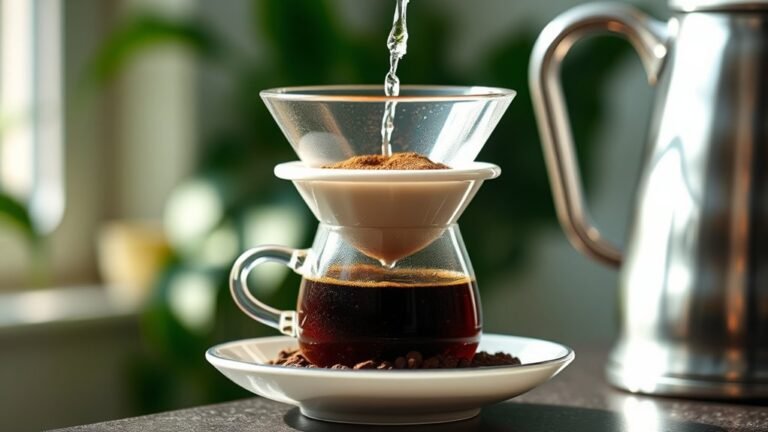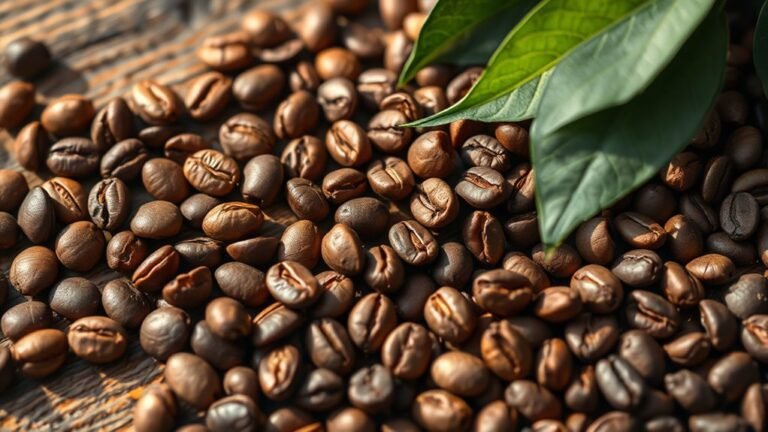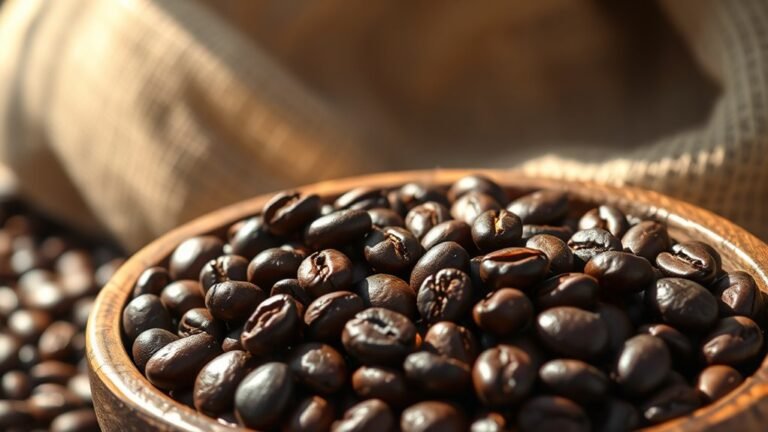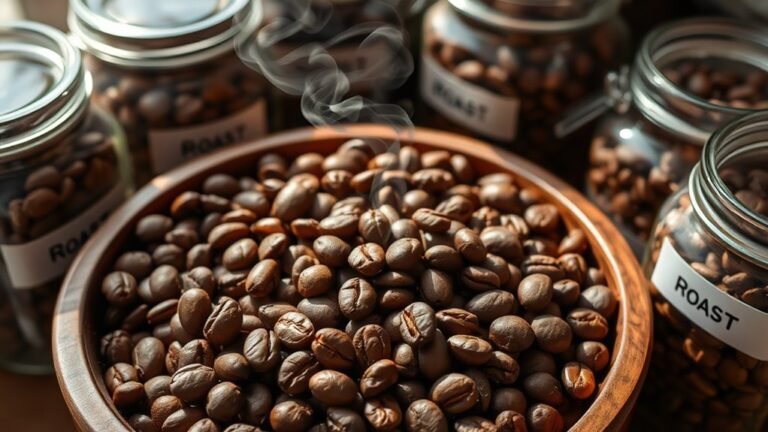The Best Coffee for Drip Coffee Makers
For drip coffee makers, choose medium roast beans like Colombian Supremo for balanced sweetness and nutty undertones, which suit their moderate extraction times. Opt for a consistent medium grind to guarantee even extraction and avoid bitterness or sourness. Beans from higher altitudes offer denser particles, enhancing clarity in your cup. Proper storage in airtight, cool containers preserves freshness. To maximize your drip brew’s flavor complexity, understanding bean origin, roast level, and grind size is essential—and exploring these factors further reveals key insights.
Choosing the Right Coffee Beans for Drip Brewing

How do you determine the ideal coffee beans for drip brewing? Start by analyzing bean origins; each region imparts distinct flavor profiles essential for your preferred cup. Ethiopian beans often deliver floral and fruity notes, while Colombian varieties tend to be balanced with nutty undertones. Central American beans generally offer bright acidity, enhancing clarity in drip coffee. You’ll want to take into account the complexity and consistency of these profiles to match your taste and brewing freedom. Additionally, the bean’s density from higher altitudes affects extraction efficiency, impacting flavor clarity. By selecting beans with origins that align with your desired flavor characteristics, you gain control over the nuances in your drip brew, enabling a personalized and liberated coffee experience every time.
Ideal Roast Levels for Drip Coffee Makers
Once you’ve identified the coffee bean origins that suit your taste, the next step is to contemplate roast levels, as they considerably influence extraction and flavor expression in drip coffee makers. Light roasts retain more origin characteristics and acidity, demanding precise temperature control for ideal extraction. Dark roasts yield bolder, more uniform flavors but can mask subtle notes.
Consider these factors when selecting roast levels for drip brewing:
- Extraction Time: Light roasts require longer extraction; dark roasts extract faster.
- Flavor Complexity: Light roasts showcase nuanced flavors; dark roasts emphasize bitterness and body.
- Grind Consistency: Match grind size precisely to roast level to avoid under or over-extraction.
- Brewing Temperature: Slightly higher temperatures benefit light roasts; moderate heat suits dark roasts.
Balancing these variables lets you harness your drip coffee maker’s full potential.
How Grind Size Affects Your Drip Coffee
Although grind size may seem like a minor detail, it critically impacts extraction rates and flavor balance in your drip coffee. Adjusting grind size controls how quickly water passes through grounds, influencing contact time and solute extraction. A finer grind increases surface area, accelerating extraction but risking over-extraction and bitterness, especially if your brewing temperature is high. Conversely, a coarser grind slows extraction, potentially yielding under-extracted, sour notes. Maintaining grind consistency is essential; uneven particles cause channeling, leading to uneven extraction and flavor imbalance. Since drip coffee makers operate within a specific brewing temperature range, optimizing grind size guarantees extraction aligns with that thermal profile. By mastering this interplay, you gain freedom to dial in a cup that matches your taste preferences, revealing the full potential of your drip coffee maker.
Top Coffee Varieties to Enhance Your Brew

Selecting the right coffee variety is essential for revealing the full spectrum of flavors in your drip coffee. Different beans offer unique flavor profiles that interact distinctly with your brewing techniques. Here are four top coffee varieties to evaluate:
- Ethiopian Yirgacheffe: Known for its bright acidity and floral notes, it complements precise water temperature control.
- Colombian Supremo: Offers balanced sweetness and nutty undertones, ideal for medium roast drip brews.
- Sumatra Mandheling: Features earthy, full-bodied flavors that thrive with longer extraction times.
- Kenyan AA: Exhibits vibrant citrus and berry flavors, demanding consistent grind size and water flow.
Tips for Storing Coffee to Maintain Freshness
Because coffee’s flavor compounds begin to degrade immediately after roasting, how you store your beans directly impacts the freshness and quality of your brew. To preserve volatile aromatics and oils, you should minimize exposure to oxygen, moisture, heat, and light. Vacuum sealing your coffee is one of the most effective methods; it extracts air, considerably slowing oxidation. Alternatively, airtight containers with one-way valves allow carbon dioxide to escape without letting oxygen in, maintaining freshness longer. Store these containers in a cool, dark place—avoid the fridge or freezer, which can introduce moisture and alter flavor profiles. Buying smaller quantities more frequently also grants you freedom to enjoy peak freshness without sacrificing flavor, ensuring each cup from your drip coffee maker delivers ideal taste every time.
Frequently Asked Questions
Can I Use Flavored Coffee in a Drip Coffee Maker?
You might think flavored coffee could clash with precise brewing techniques, yet it’s perfectly usable in a drip coffee maker. The oils and additives in flavored coffee can sometimes clog filters or alter extraction, affecting taste and machine performance. However, if you enjoy experimenting and value freedom in your cup, just guarantee your drip machine is cleaned regularly. This balance lets you savor unique flavors without sacrificing brewing quality or equipment longevity.
How Does Water Temperature Impact Drip Coffee Taste?
You’ll find water temperature essential because it controls water extraction during brewing. If it’s too hot, you risk over-extracting, leading to bitterness; if too cool, under-extraction results in weak, sour flavors. Ideal brewing usually occurs between 195°F and 205°F, ensuring balanced extraction of coffee compounds. By mastering this, you gain freedom to tailor your coffee’s taste profile, revealing richer, more nuanced flavors with every drip.
What Is the Best Water-To-Coffee Ratio for Drip Brewers?
Imagine unfastening the perfect harmony between water and coffee—your gateway to true coffee strength. For drip brewers, the ideal water-to-coffee ratio hovers around 16:1, meaning 16 grams of water per gram of coffee. This balance guarantees peak extraction during your brewing time, preventing over or under-extraction. Adjusting this ratio lets you tailor strength, granting you freedom to brew coffee that matches your precise taste preferences every time.
Are Reusable Coffee Filters Better Than Paper Filters?
If you’re weighing reusable coffee filters against paper ones, consider environmental impact and cost comparison. Reusable filters reduce waste, lowering your ecological footprint over time, while paper filters create ongoing trash. Although reusable filters require upfront investment, they save money long-term by eliminating the need for constant repurchasing. You get the freedom to brew sustainably and economically, but remember, maintenance and cleaning are essential to keep flavor purity intact.
How Often Should I Clean My Drip Coffee Maker?
Wondering about the perfect cleaning frequency for your drip coffee maker? Don’t wait until buildup affects taste or function. Experts recommend a thorough cleaning every 40 brew cycles or about once a month, depending on usage. Maintenance tips include descaling with a vinegar solution or a commercial cleaner and rinsing all removable parts regularly. Staying consistent guarantees peak performance, prolongs your machine’s life, and lets you enjoy freedom in every cup.






